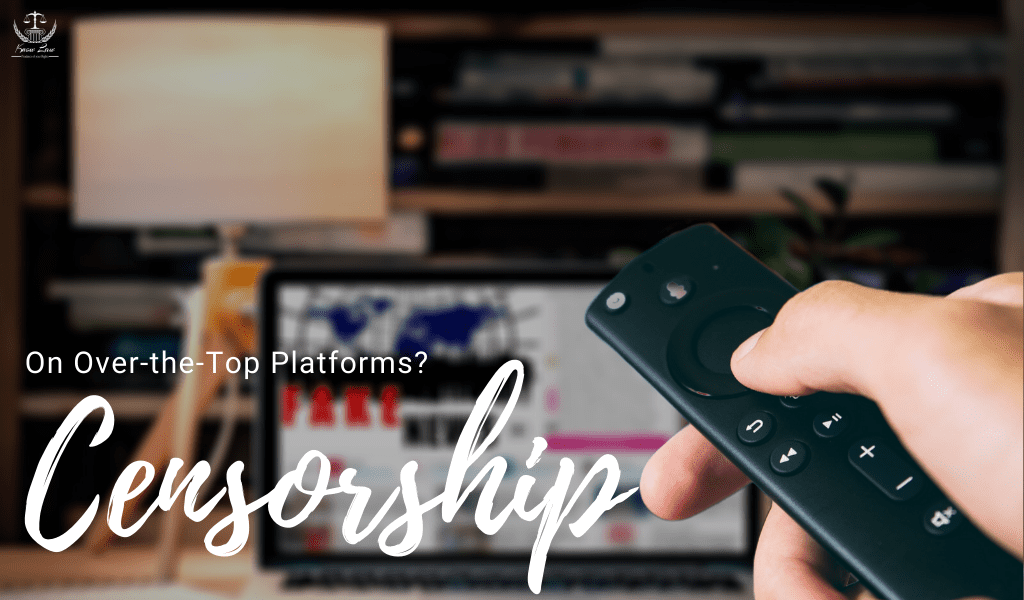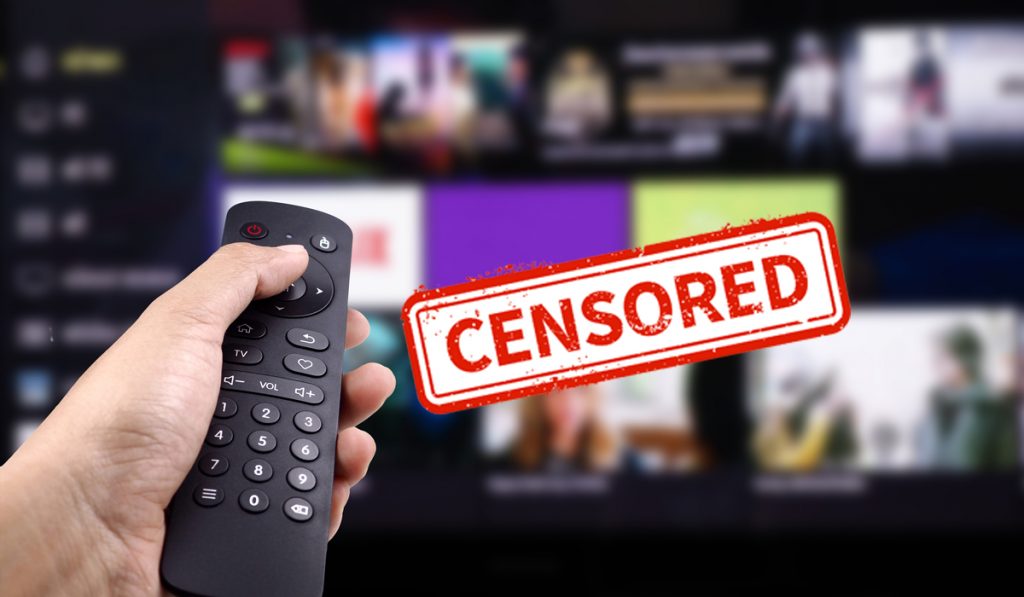
A blessing? A curse? Or a bit of both? The categorization of OTT (Over-the-top) platforms such as Amazon Prime, Netflix, Hulu, Hotstar, Spotify, and so on would depend on a person’s slant as for questions of government control and arbitrariness, artistic freedom and creativity, cultural transmission through tools of mass communication and on the debate regarding censorship in general.
Over-the-top platforms refer to those services that stream videos and audio over the internet and enable the public to access its contents by way of membership, subscription, renting, or buying. Over the years, OTT platforms have become synonymous with video streaming services and this article will delve into the regulation and censorship of works released on these giant platforms whose growth has been surprisingly exponential.
How are Movies and Series released on OTT Platforms?
To publish content on these platforms, one has to submit the videos to them which will then be scrutinized by the particular company taking into account a multiplicity of factors. These factors orbit the customers. They collect data on the interests and preferences of their customers to approve the content submitted to them for publication. According to the publication and licensing policy of Amazon Prime, ‘Before a licensing decision can be made, we assess your submission through a series of automated and manual reviews which can take up to three weeks. We look for content that delights and engages our customers, improves our curated catalog, and elevates our service.’ Essentially, they allow the publishing of those works under popular.
Hence, it is not baffling to see the reason behind why a significant number of films and web series, especially those originally produced by these platforms, lean towards portraying contrasts in society, the hard truths, the hypocrisy to which most turn a blind eye and generally steps away from the conservative inclination taken by films and television series of yesteryears.
The review does not stop there. These works are even subjected to post-publishing reviews. If the content does not engage with the user base, they face the risk of being taken down. In essence, over-the-top platforms are self-regulated and function outside the ambit of certification and censorship legislation in India applicable to cinema released via theatres.
What do we mean by the term Censorship?
The Oxford English Dictionary defines censorship as – the suppression or prohibition of any parts of books, films, news, etc., that are considered obscene, politically unacceptable, or a threat to security. Some argue that censorship infringes upon the fundamental right to freedom of speech and expression enshrined in Article 19(1)(a) of the Constitution of India for citizens. Be that as it may, Article 19(1)(a) is subject to ‘reasonable restrictions’ in Article 19(2) which lists the circumstances when the right to free speech and expression may be curtailed. It must be in the interests of the sovereignty and integrity of India, the security of the State, friendly relations with foreign States, public order, decency or morality, or in relation to contempt of court, defamation, or incitement to an offense.
Instances of Censorship
Films and other like content to be released to the public are regulated by The Cinematograph Act, 1952. Cinema is undoubtedly one of the greatest and enthralling inventions of all time. It has inspired billions, opened the eyes of multitudes to unspoken atrocities, given birth to riots, joined the hands of many, and has interwoven cultures across the world. Cinema has occupied a position of rare merit in the hearts of many and is regarded with great favor among the numerous other art forms. Nothing influences the masses more than cinema. The Indian entertainment industry is unmatched in the world with the number of productions each year going over a thousand. The impact that cinema is of such great magnitude that we have a statutory regulatory body established under The Cinematograph Act – the Central Board of Film Certification (CBFC) that views and certifies films.
Due to the effectiveness of films and television series as a tool of mass communication and cultural transmission, the CBFC is empowered to categorize works into four, namely, ‘U’ for unrestricted public expression, ‘UA’ for unrestricted public exhibition subject to parental guidance for children below the age of twelve, ‘A’ for those works restricted to adult audiences and ‘S’ for works restricted to specialized audiences. Even though CBFC functions to certify films, the body is authorized to deny certification to the films, leading to censorship.
In K. A. Abbas v. The Union of India, the Supreme Court held that “Censorship of films including prior restraint is justified under the Constitution.” The apex court opined that motion pictures must be treated differently from other forms of art and expression considering their instant appeal, versatility, realism, and often, surrealism.
CBFC’s Power of Censorship
The CBFC does not have the power to censor films submitted to it for certification, but it can deny certification if the work contravenes Section 5(b) of The Cinematograph Act. Section 5(b) of the Act deals with the principles of guidance in certifying films and resonates with Article 19(2) of the Constitution of India in listing the grounds for restrictions. This provision leaves the makers and producers of films with no choice but to cut out the objectionable parts from the film if they want approval. For those who have invested sweat, blood, and a substantial amount of money in the film, making changes as per the directions of CBFC is the only way to get the requisite ‘return on investment’. Therefore, in a way, the decision is being taken out of their hands and they are forced to censor their work.
Even though the restrictions imposed by the legislation are reasonable as has been reiterated by the Supreme Court of India, what people object to and cannot digest is the overarching and often dubitable stances taken by the CBFC. The body has been criticized for having conservative attitudes inconsistent with the changing times and progressive societal norms.
In the present scenario, films and web series being uploaded on OTT platforms are able to circumvent the overarching net of the regulatory body.
How do OTT Platforms escape the ambit of Censorship and Certification in India?
In Justice for Rights Foundation v. Union of India, the Ministry of Information and Broadcasting filed an affidavit stating that ‘the online platform is not required to obtain any license from the Ministry of Information or Broadcasting for displaying their contents and the same is not regulated by the said Ministry.‘ The Ministry of Electronics and Information Technology had informed that they do not have the authority to regulate the content on the internet and ‘there is no provision for regulating or licensing for an organization or establishment for putting up content on the internet.‘
This does not mean that over-the-top platforms are outside the legal realm. They are indeed subject to the provisions of the Information Technology Act, 2000, and the concerned statutory authorities are empowered to take action against under S. 69 of the Act which provides for the ‘power to issue directions for interception or monitoring or decryption of any information through any computer resource‘ and under S. 69A providing for ‘power to issue directions for blocking for public access of any information through any computer resource.‘
Hence, if the content on such platforms violates the provisions of the Information Technology Act and contains prohibitory material, complaints can be made to the concerned statutory authority.

In Padmanabh Shankar v. Union of India, a writ petition was filed under Articles 226 and 227 before the Karnataka High Court praying that “the transmission or broadcast of any films, cinema, serials and other multimedia content through the internet shall come within the definition of Section 2(c) of The Cinematograph Act, 1952.” The High Court made an interesting observation that it was difficult to accept that there is an ‘exhibition’ of films and serials over the internet.
The Court rejected the submission that films and serials transmitted through the internet would constitute the meaning of ‘film’ under Clause(dd) of S. 2 of the Act. The Court observed that the internet was an interconnected network of web-servers worldwide that merely transferred files in response to the requests made by the users, using Hypertext Transfer Protocol (HTTP). Thus, it was held that the transmission or broadcasting of films and serials would not come under the ambit of The Cinematograph Act.
Instances of complaints against content published on OTT Platforms
There has been an exponential growth of such platforms over the years with Netflix and Amazon Prime leading the charts with their curated content. India’s population has been able to reach out to more liberal content that encourages different perspectives on social, economic, and political issues and is rich in significance.
During the nationwide lockdown, there was a surge in the user base of such platforms which brought the issue of regulation and censorship of online content to the spotlight. A few instances of public outrage at certain web series are noteworthy. The most recent issue has been surrounding the web series ‘Mirzapur’. A PIL (Public Interest Litigation) was filed on the grounds that the web series ‘completely tarnished the historical and cultural image‘ of Mirzapur and depicted it as a city/district of goons, vagabonds, and adulterers. It was also contended that the series was full of nudity and vulgarity. The Supreme Court has issued a notice to Amazon Prime Video, the Central Government, and Excel Entertainment, the producer of the show.
This comes amid the controversy surrounding another web series titled ‘Tandav’. The cast and crew of the Amazon Prime show apologized after the political drama was accused of being insensitive to Hindus.
Self-Regulation on OTT Platforms
The present position of OTT platforms can be summed up as follows:
- They are not subject to the provisions of The Cinematograph Act, 1952.
- They are subject to the provisions of the Information Technology Act, 2000.
- The only review being done of the films and web series is by the OTT platforms publishing the content and not by the CBFC.
Hence, before any legislation or guidelines are brought in for the regulation, certification, and censorship of films and like media on OTT platforms, the companies need to be responsible enough to regulate the content on their own in good faith and their policies can be aligned with Article 19(2) of the Constitution of India and Section 5(b) of The Cinematograph Act.
Conclusion
Instances of public dissent have underlined the need for regulation, certification, and censorship of content being published on over-the-top platforms. Such regulation should be based on constitutional principles considering the changes in society that are essential for our country to gallop towards becoming a unified one. It cannot be denied that such platforms have accentuated the requirement for broad-minded cinema in our social setups, but that does negate the need for monitoring their publications.
What we need is a balanced assessment of the content against a backdrop of constitutional principles, liberal and progressive attitude, tolerance, mutual respect, artistic freedom, need for a socially, economically, politically, and environmentally aware youth, and the betterment of society at large.
Editor’s Note
The above article questions the need for censorship on OTT platforms, which constitute a major part of the cinematography this nation holds in this day and age. The answer lies between the balance that must be achieved between the constitutional principles we are subject to and the creativity and development in the field of cinematography.
Both cannot be left unattended. Various Acts like Information Technology Act, 2000 and other statutory authorities are empowered to take action and this makes content on OTT platforms come under the ambit of censorship. Various instances and cases have been provided in the article explaining the same.